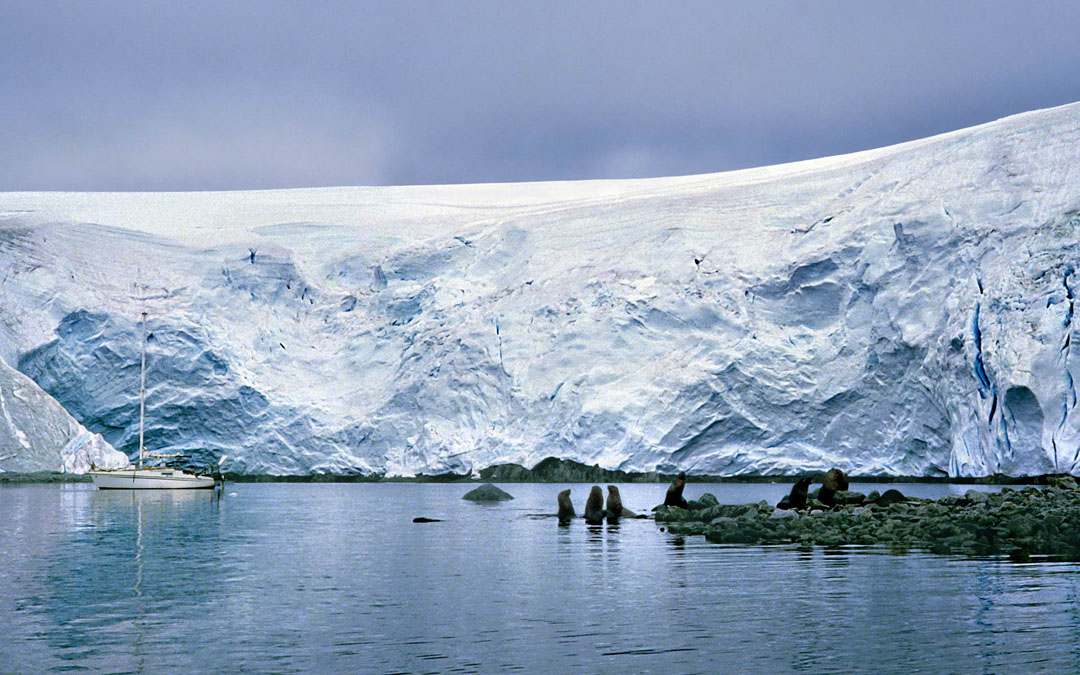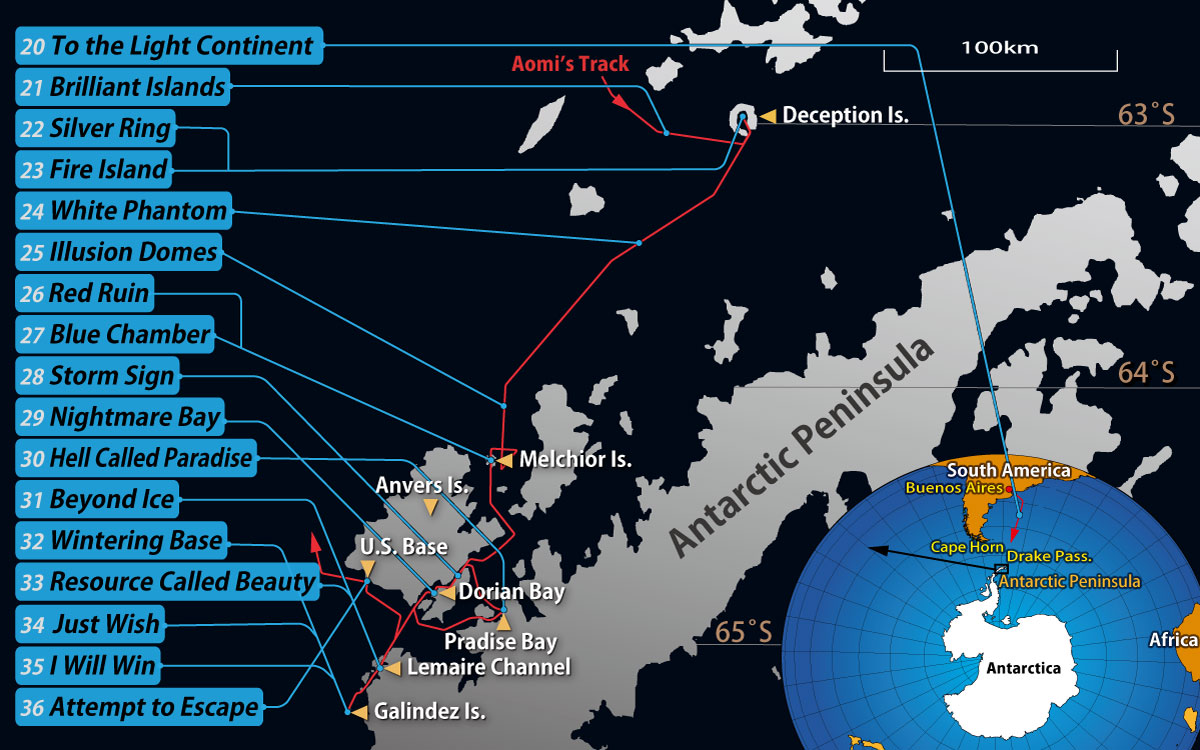27. Blue Chamber

Eventually, Aomi runs aground—in the Antarctic, of all places.
Since the beginning of human history, how many ships have visited this small bay? It is also the end of summer, the season when ships leave the Antarctic.
There is no hope that Aomi will be discovered here. It is a hidden bay, like a chamber surrounded by ice domes and pale walls, cut off from the outside world. Do I have to spend the winter here alone if I cannot escape the reef?
I climb the mast steps I designed and installed in Buenos Aires for this Antarctic voyage. From the mast top, I look down at the small bay.
Yet the shallow water stretches out before me like a wasteland, each stone on the seafloor visible, as though I could count them one by one.
As if falling, I descend the mast. I lower the dinghy into the water and step into it. Then I lean over and check the seafloor from the lowest angle I can reach.
Unfortunately, the ballast sticking out from Aomi’s bottom has hit a rock, with another small rock just behind it. She has leapt over one rock and become stuck between two.
I immediately put the engine in reverse and try to back out, but even as I increase the engine speed (RPM), nothing happens. I alternate between forward and reverse, attempting a U-turn as well, but nothing works.
I grip a wire that supports the mast and lean my weight to one side of Aomi, hoping to tilt the hull enough to lift the bottom off the seafloor.
Even then, Aomi’s small hull, which usually tilts easily, stays level and does not move an inch.
I shift the supplies: food, water, and tools to one side of the cabin and try again, but it is no use. Aomi is completely on the shoal and does not move at all.
I hastily load an anchor into the dinghy and row about 50 meters toward deeper water. After dropping the anchor, I row back to Aomi and pull the anchor line using the winch. Once the anchor bites into the seafloor, Aomi’s hull should shift back, freeing her from the shoal.
But no matter how hard I pull or how much force I apply to the winch handle, the anchor rope only tightens, and Aomi does not move at all, as if her hull were fixed to the seafloor with concrete.
I put the engine in reverse and increase the RPMs. With the added power of the winch, this should work; this must work.
But no matter how hard I try, even when I push the RPMs to the limit, Aomi does not move at all.
I feel desperate for a while, but I should have enough food to last about three months. I can make fresh water for cooking by melting ice, and I have 30 liters of kerosene left for that.
By that time, I will run out of food and fuel, and it will be midwinter in the Antarctic. If I am determined to leave Aomi, I might be able to walk across the frozen sea to the nearest manned base, a U.S. base 100 kilometers away.
No, I have absolutely no intention of abandoning Aomi!
I keep trying to free Aomi from the shoal, never giving up. I push the engine to full power and put all my strength into the winch handle, even doubting it will work.
After an hour, the winch handle suddenly lightens, and the anchor rope loosens, which had been as taut as an iron bar. Fortunately, the tide is rising, and Aomi’s hull lifts just enough to free the ballast from the rocks.
Quickly slipping away from the shoal, Aomi moves between the white domes and anchors in the next bay I have chosen from the chart.
For the first time in two and a half days since leaving the volcanic island, I can finally rest. Sailing alone in the Antarctic is exhausting, and I am running out of strength.
In a pentagon-shaped bay surrounded by ice domes, Aomi drops anchor. Seals occasionally poke their heads above the water, circling Aomi as they glide past.
Along the bay’s shore, a vertical ice wall, about 40 meters high, crumbles into the sea several times an hour, releasing a thunderous roar.
The ice cliffs appear bluish, as though they have been dyed with blue ink. They also look like masses of compressed blue mineral crystals. This impressive blue penetrates deep into my heart, as though it comes from another world.
By sunset, countless ice blocks that have broken off the cliffs are carried by the tide, completely surrounding Aomi and leaving no way out.
In the cold cabin, where the temperature hovers around 2 degrees Celsius, I open several nautical charts from different publishers and compare possible routes to the Antarctic continent.
Surprisingly, some charts show coastlines with dotted lines due to uncertainty, while others contain unusual notes, likely due to insufficient data.
“Commanding officers of ships using this chart are requested to add ship’s track, soundings, aids and dangers to navigation, any pertinent remarks, and return the chart to…”
Can I reach the Antarctic continent without running aground again in this sea of sparse information?
I put my worries down in Aomi’s logbook, then fall asleep in my cold berth.
For more details, see the Explanation page.


Hi! Any questions or suggestions about the content are greatly appreciated.
I’d also love writing tips from native English speakers. Since English isn’t my first language, if you notice any awkward phrases or anything that seems off, please let me know.
Thank you!
E-mail